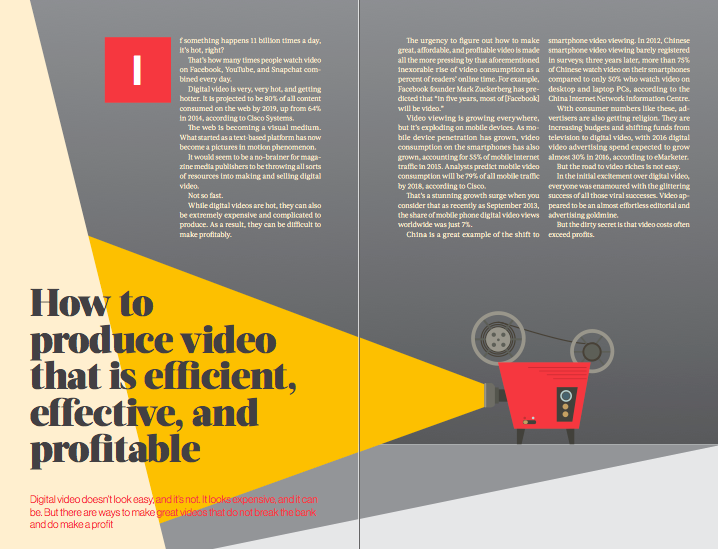
25 Nov How to produce video that is efficient, effective, and profitable
Digital video doesn’t look easy, and it’s not. It looks expensive, and it can be. But there are ways to make great videos that do not break the bank and do make a profit.
If something happens 11 billion times a day, it’s hot, right?
That’s how many times people watch video on Facebook, YouTube, and Snapchat combined every day.
Digital video is very, very hot, and getting hotter. It is projected to be 80% of all content consumed on the web by 2019, up from 64% in 2014, according to Cisco Systems.
The web is becoming a visual medium. What started as a text-based platform has now become a pictures in motion phenomenon.
It would seem to be a no-brainer for magazine media publishers to be throwing all sorts of resources into making and selling digital video.
Not so fast.
While digital videos are hot, they can also be extremely expensive and complicated to produce. As a result, they can be difficult to make profitably.
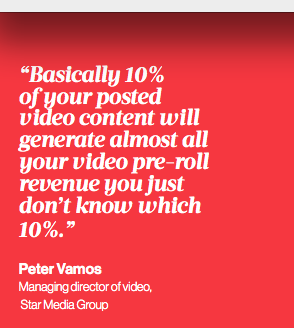
It isn’t cheap
“Publishers have long held pre-roll as the focal point of their video revenue strategies — a seminal tactic when discussing the potential of untapped revenue streams,” wrote Peter Vamos, managing director of video at Star Media Group in Toronto, for the International News Media Association (INMA). “Best-in-class CPMs, the opportunity to maximise inventory, and the fact that it is directly attached to con- tent with high engagement all make pre-roll an extremely appealing ad unit.
“That’s the story we love to hear,” Vamos wrote. “But the uncomfortable truth is that generating margin on pre-roll is, more often than not, a break-even proposition at best. In fact, unless you have massive scale, it is virtually impossible to profit from pre-roll.”
“The more video revenue you generate, the higher your costs go,” Vamos wrote. “These costs include bandwidth, video platform streaming, content acquisition, and staffing and production gear.”

Vamos pointed out that:
- Continuing to engage audiences requires creating or licensing more and better content
- Streaming costs increase with audience engagement
- Ad serving costs increase with streams
- It’s tough to generate a good margin without scale
It’s even harder when you consider that “basically 10% of your posted video content will generate almost all your video pre-roll revenue — you just don’t know which 10%,” wrote Vamos for INMA.
Here’s what it looked like when Vamos broke it down:
- As a percentage of annual revenue: Pre-roll, 100%
- Cost of revenues: Content, 50%; streaming: 32%; cost of sales, 15%
- Total costs: 97% • Margin: 3%
A three percent margin is a tough sell, especially as it does not include staff and equipment costs.
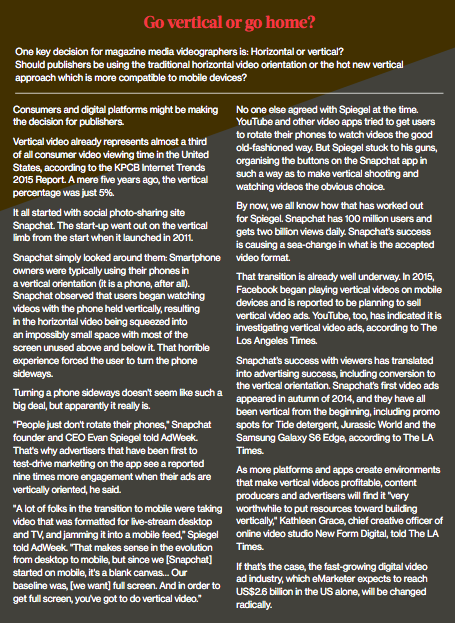
Strategies for a viable video business model
In his INMA piece, Vamos recommended four strategies for a viable video business model:
1. Use traditional avenues (video monetised by pre-roll) to build and engage video audiences, and pay for our business
2. Launch products with more manageable content creation or acquisition costs. Many publishers have embraced providers that package a video platform, content streamed into the platform and pre-roll sales. These are generally provided on revenue-share deals where the provider covers all costs and simply cuts a check to the publisher at the end of each month. The downside is, of course, that much of the content is the same as what audiences can find on competitor sites, and because the scale is massive, CPMs tend to be lower
3. Layer on other types of initiatives and products with lower streaming costs that lever- age your audiences. A product that has been making significant headway in the last year is InArticle or InStream video ads. These are ads that appear directly within an article, where the text on a story page parts and a video ad begins streaming with volume usually muted. This solution is particularly intriguing because it removes the video ad entirely from the video content and lever- ages a significantly larger pool of inventory, potentially every article on your site
4. Finally, there is the creation of branded video programming for clients. This should be an easy one for publishers to grasp since creating advertorials and custom publishing has been around for a long, long time. This comes in the form of channel sponsorships, custom brand integrations, and native con- tent opportunities for advertising partners.
Another way to keep video production costs down is to “amortise” your videos. Time Inc. and Meredith, for example, plan their video schedule to include as much evergreen content as possible, enabling them to republish it regularly for a greater return.
At food site Eater, too, much of their video content is not tied to a specific time or event, creating an opportunity to expose their audience to it multiple times, New York Eater editor Greg Morabito told Vox Marketing.
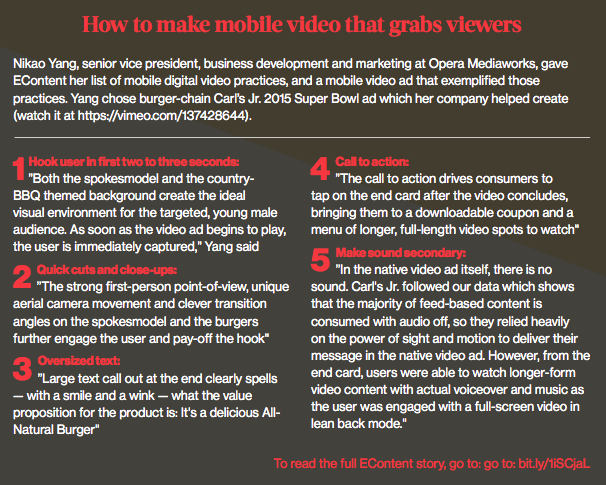
Meredith also keeps cost down by creating video based on still photography. “It has been surprisingly successful,” Meredith vice president, video production Laura Rowley told Digiday.
Yet another trick is to make videos that actually generate income. California-based Fuisz Media is a start-up creating systems that make video ads interactive. Fuisz ads are actionable, enabling viewers to click, tap or hover over an ad and see more information about a product or service, and even make a purchase. Gillette, Ford, Victoria’s Secret, and dozens of other advertisers have given it a try, according to The Los Angeles Times.
Similarly, in early 2015, Elle Canada created three 45- to 60-second shoppable videos for Dior to promote — and sell — products from a new “Instant Beauty Solution” collection.
A series of highlighted dots appear throughout the Elle videos, inviting viewers to click to buy the featured products, and each video ends with an invitation to sign up for a free consultation, according to Canadian magazine Marketing.
Elle Canada launched its first shoppable video in 2014 with clothier Hudson’s Bay. When Elle sent e-notifications about the videos to their readers, they achieved a 78% open rate and a 12% click-through rate. “We exceeded on every metric we set out to succeed upon,” Jacqueline Loch, vice president and group publisher, told Canada’s Marketing magazine.
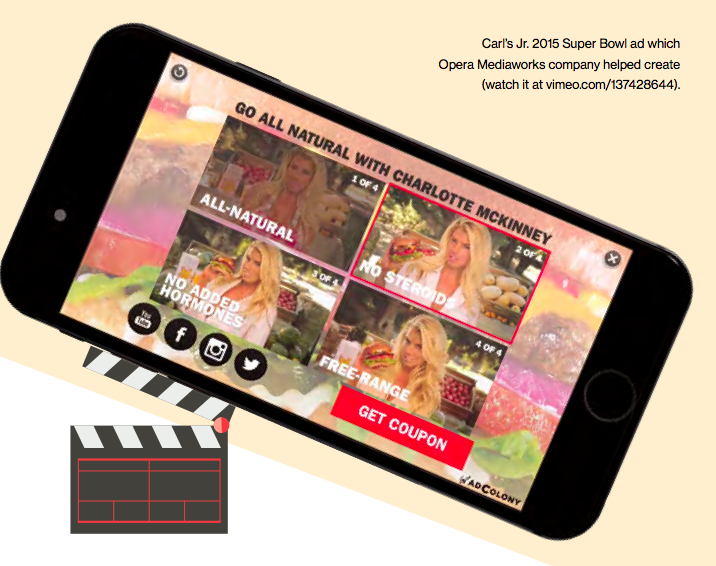
Can you hear me now?
The challenge of making successful digital video is made even more difficult by the trend toward auto-streaming video with the sound off. That might seem like sending a boxer into the ring with one hand tied behind his back. Instagram kicked off the practice in 2013, followed late the same year by Facebook, and in mid-2015, Twitter followed suit.
While it might make grabbing the reader’s attention more difficult, if you think about where mobile video consumption takes place, silent autoplay makes sense. Desktop video watchers are often alone and have headphones available. Not so mobile users. They are often in situations, like a library, cafe, or subway, where listening to loud audio would be rude and disruptive.
Mike Hayes, global digital marketing man- ager at ice cream maker Ben & Jerry’s, told The Wall Street Journal that he is producing video ads that communicate just as well without sound. Hayes cited digital video ads featuring close ups of ice cream products accompanied by on-screen text, as well as a video featuring a pint of ice cream trapped in a slowly melting block of ice.
Without sound, auto play videos have, at most, three seconds to get a reader’s attention, according to various video experts. Editorial and advertising videos must be un-skippable. “You’ve got someone scrolling over the thing, and you’ve got to grab him by the throat quickly,” Adam Wohl, executive creative director at the agency McGarry Bowen told The Journal. “On TV, you can let things play out.”
One tool to grab readers attention in a volume-free video environment is, surprise, text! Videos must be read as easily as they’re watched. Text overlays tell the story whether the volume is on or not.
“The idea is to make videos on these plat- forms volume-agnostic,” Steven Belser, vice president of production and creative at distributed media company NowThis, told Digiday. “It’s about giving people an option to watch both with audio and without it. Even with volume on, the text on screen doesn’t detract from the product in any way.”

Being really clever, some video producers,like hotel-booking site hotels.com, are making videos whose content is text-heavy if the volume is muted, but has more audio if the audio is on.
Ratcheting the clever quotient to the next level, some video makers try to entice the viewer to turn the volume up. Capital One for example, had actress Jennifer Garner appear to be knocking on the viewer’s screen, which triggered a volume icon to appear.
If you can, go all in
If you have the budget, go for it. Time Inc., for example, has more than 40 full-time producers. They are assigned to magazine brands ac- cording to their expertise so they are at least familiar with the content. Time Inc. senior vice president of video J.R. McCabe insists that the video team attend daily editorial meetings so they are part of the planning process at the beginning.
Meredith has a 12-person video department creating video across all brands as well as original series unattached to brands with stand-alone business models, such as the Better Homes and Gardens TV show with Net2TV, or the parenting video series “Lords of the Playground”.
In both cases, centralising video production ensures efficiency in companies with multiple brands covering similar topics. The risk of duplication of effort, such as having multiple titles doing the same holiday cookie recipe, is reduced or eliminated, freeing up resources to do more original work.
Meredith also tries to increase the profitability of its videos by holding down costs and risks. They do mostly low-tech videos that audience data indicates will be welcomed by viewers.
More modestly, business site Quartz hired a three-person digital team and embedded them in the newsroom. “One thing that’s really, re- ally important is that they’re integrated in our site and our newsroom,” Delaney wrote. “They sit in the middle of everything.” They’ll also help create tools so that all Quartz journalists can create simple videos the way they’ve used Chartbuilder with graphics,” he said.
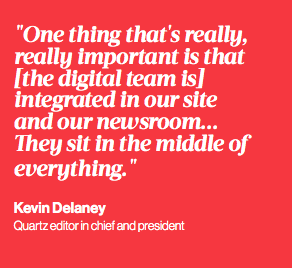
International technology publishing company IDG recently created a 12-person video production team untethered to any of their many individual publications, including PCWorld, Network World, CIO, and MacWorld. Decoupling video from its publications also provides IDG with more creative and editorial flexibility, Dina Roman, general manager of IDG.tv told Digiday.
If a tree falls in the woods and no one is around…
What’s the point of all this digital video effort if it isn’t promoted?
“Traditional publishers have made great headway to reinvent their content strategy and distribution model, but they are contending with publishers outside their traditional competitive set with stronger targeting capabilities and pricing structures,” Robin Steinberg, executive vice president, publishing and digital director of media specialist agency MediaVest, told Digiday. “Due to their traditional print legacy position in the marketplace, they have to push harder for a prime seat at the digital video marketplace table.”
Condé Nast has set a high bar when it comes to dedicating serious resources to promotion. For every dollar spent on video creation, a dollar is set aside to market that video. The strategy is working spectacularly: The company hit the one billion video view mark in July 2015. “You hear about creation,” Fred Santarpia, chief digital officer for the three year old Condé Nast Entertainment told Digiday. “You don’t hear a lot about the audience development side of the business.”
Some brands, like Meredith, promote internally through their own publications, websites, and social media sites. That strategy has a fortuitous side-effect. The video division understands that to get internal promotion, they can only create video that the brand’s editors believe in. “If they’re not invested in it, we won’t do it, because they won’t promote it,” Rowley told Digiday.
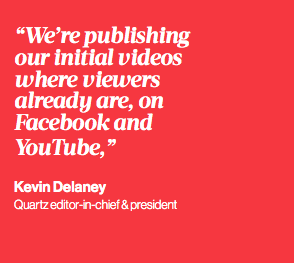
How to decide where to post videos
For better or worse, the hottest spot for digital video today is Facebook.
For example, when staffers at food site Eater. com did a “test drive” with Facebook by posting a dozen videos exclusively on Facebook, the results were crystal clear: Eater fans shared those posts 12 times more often than posts with links to video outside of Facebook.
After that test, “native” Facebook video uploads became a core element of Eater’s video distribution strategy. Specific content ideas and formats are created based on what the Facebook audience was responding to and what the data was telling the team, Eater New York editor Greg Morabito told Vox Marketing.
The data told them that “the most successful videos start with action right away, and need little or no explanation,” Morabito told Vox. The data also told them that “teasers, talking heads, and low-brow food posts don’t work.
Audiences shared videos about chefs making incredible things. They also shared smart text- heavy videos about high-brow dining.” When business site Quartz started doing digital video, they instinctively went only to Facebook, with YouTube thrown in for good measure. “We’re publishing our initial videos where viewers already are, on Facebook and YouTube,” wrote Quartz editor-in-chief and president Kevin Delaney on the company blog. “We’re also embedding them in a YouTube player on qz.com for our loyal readers whenever that makes sense.
“In our first few weeks, we’ve already published one major viral hit, a science video with over 15 million views on Facebook,” wrote Delaney. “Other videos have had significant success.”
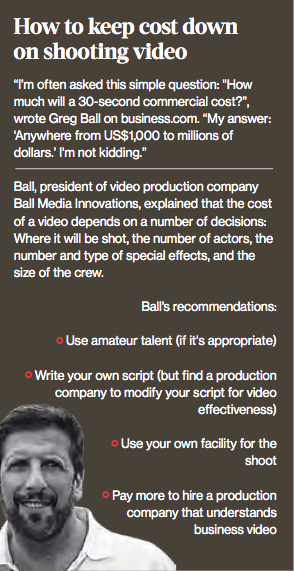
The New Yorker follows a similar, if more liberal, playbook, posting on Facebook, Snapchat, YouTube, AOL, and parent company Condé Nast’s video portal, The Scene.
But The New Yorker has found another very effective place to publish their videos: at the end of their own stories.
“In June 2015, we started embedding videos at the bottom of some blog posts and features,” Nicholas Thompson, then the NewYorker.com editor, told Digiday. “If you embed a video at the bottom, users are more likely to stay on the site than if they saw only text links.”
All the strategies delivered impressive results: The New Yorker told Digiday last August that video views were up 294% year to date on its website alone, and video ad revenue was up 420%. (For more on where to publish, please see the story in this book on Distribution Models.)
Surprise, viewers WILL watch longer videos
For years, it has been accepted wisdom that digital video consumers, especially those on mobile devices, will only watch very short videos. Quick, funny snippets of kitties or stupid people behaving humorously.
Well, it’s time to re-examine the accepted wisdom.
According to an Interactive Advertising Bureau (IAB) study of worldwide usage of mobile video, more than a third of the global respondents said they watched videos longer than five minutes… on their phones! Even the study authors were surprised: “It is more common than expected,” they admitted.
In line with that finding, more than a third of respondents also admitted they are watching more video on their smartphones than they More good news: The increase in mobile video viewing is eating into consumers’ television habits. One-fifth of respondents said their time spent watching mobile video is coming at the expense of their time with television.
“As we’re seeing the younger consumers start to shift to digital video, we’re seeing money migrate from cable into digital video,” Dawn Ostroff, president of Condé Nast Entertainment, told AdWeek.
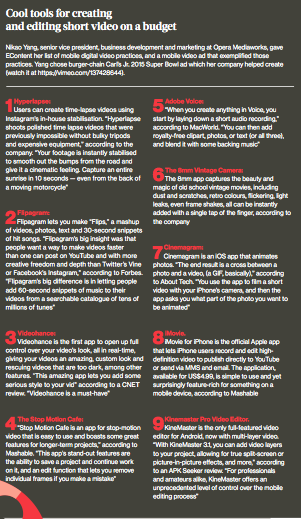
A new survey from Unruly reveals that 70% of US advertisers have shifted a portion of their TV ad budgets to programmatic online video ads in the past 12 months, according to VideoNuze.
Spending growth in the categories of rich media and video will both be significant: 36.4% and 28.5%, respectively, according to the US Digital Display Advertising Trends report by eMarketer.
With 11 billion video views a day, it’s only a matter of time before ad dollars catch up to eyeballs.
If magazine media publishers are going to be there when the digital video ad coffers open up, they must figure out how to make affordable, efficient, multi-purpose, ad-friendly videos.
There’s no time to waste.



